Mari › Enki » Ancient origins
Articles and Definitions › Contents
- Mari › Who Was
- Enki › Who Was
Ancient civilizations › Historical and archaeological sites
Mari › Who Was
Definition and Origins
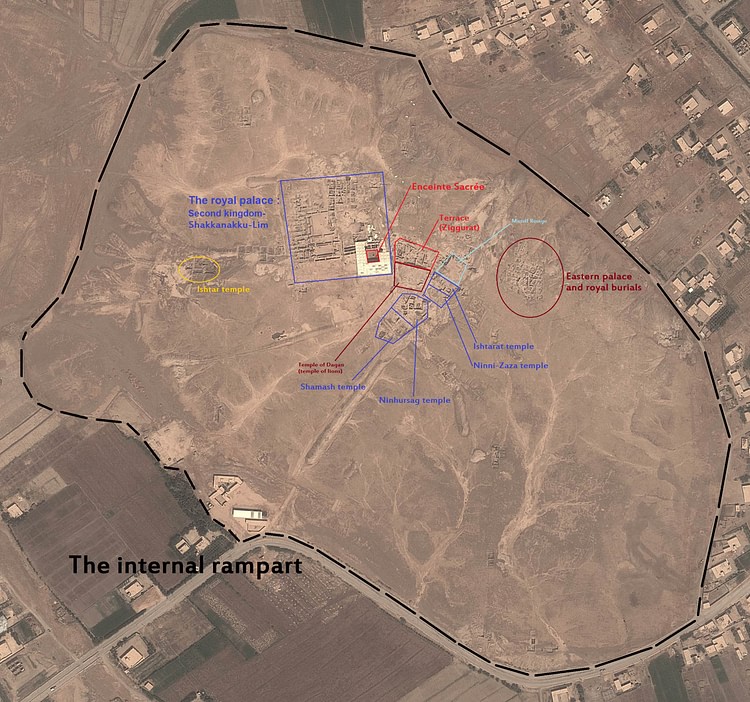
Mari was a city-state located near the west bank of the Euphrates River in Northern Mesopotamia (now eastern Syria ) during the Early Bronze Age and the Middle Bronze Age. One of the earliest known planned cities, Mari is believed to have been founded as a trade hub, and copper and bronze-smelting centre, between Babylonia in Southern Mesopotamia and the resource-rich Taurus Mountains of modern Turkey. For 1,200 years, Mari served as a major centre of Northern Mesopotamia until it was destroyed by Hammurabi of Babylon between 1760 BCE and 1757 BCE and gradually eroded away from memory and quite literally - today only one-third of the city survives with the rest washed away by the Euphrates.
GEOGRAPHY & CONDITION OF THE SITE
The ruins of Mari are located at modern-day Tell Hariri in eastern Syria. In the Bronze Age, the Euphrates was around 4-6 km from the city but has since moved farther east. The city is believed to have been constructed along with a 10 km long man-made "linking canal" that once cut through the city and provided water essential for the city's existence as the city itself was too far from the Euphrates for daily water retrieval on foot and the ground water is too salty for wells. As a result of the destruction of Mari by Hammurabi, Mari's linkage canal expanded outside of its intended boundaries and eventually eroded away two-thirds of the city, including most of the housing from the third and last phase of the city.
CANALS: THE LIFE-BLOOD OF MARI
In addition to providing water for the city, the linkage canal also gave easy access for trading ships travelling on the river. Along with the linkage canal, two other substantial canals were constructed by the city's builders. One was an irrigation canal, 16 km long and 100 m wide, and the other was a 126 km long navigational canal which ran past Mari on the opposite side of the Euphrates and allowed boats to bypass the winding Euphrates in favour of a straight passage - Mari controlled the entry points and profited from tolls.
TECHNOLOGICAL & ARCHITECTURAL INNOVATIONS
Mari is an early example of complex urban planning and is believed to have been entirely planned out prior to its actual construction by another unknown but complex society. This is evident in Mari's overall design as the city was built as two concentric rings, the outer ring intended to protect the city from the occasional violent floods of the Euphrates, and the inner ring designed to defend against attackers.
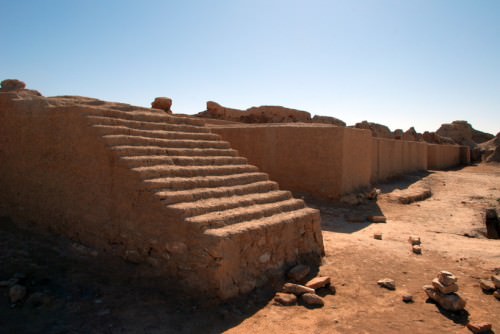
A portion of wall at Mari
The earliest examples of certain Syro-Mesopotamian technologies were excavated by archaeologists at Tell Hariri, including the wheel and plumbing. Mari was built so that the whole city sloped gradually downwards, and the streets had complex drainage systems. This meant rainwater from the occasional torrential rains could be safely drained out of the city without risking damage to the buildings which were all made from mudbrick.
ARCHAEOLOGY & MODERN PERILS
Mari was discovered in 1933 CE by a local Bedouin who found a statue and informed the French government - this was a period when Syria was controlled by France. Since then, Mari has been a French-excavated site, with most of the literature on the site published in French. It was excavated by André Parrot from 1933–1939 CE, 1951–1954 CE, and 1960–1974 CE. In 1979 CE, a new expedition began under Jean-Claude Margueron, who ran the excavation until 2004 CE.
After he retired and gave his responsibilities over to Pascal Butterlin, Margueron went on to write a book on Mari, which compressed 70 years of scholarship on the site into a 159-page English-language summary, which forms the basis of this definition. Butterlin ran the excavations up to 2012 CE when the Syrian Civil War placed further excavation on hold indefinitely.Since 2012 CE, Mari has faced extensive looting, the impact of which is not yet known.
MARI TABLETS
Between 1933 CE and 1938 CE, excavators uncovered over 15,000 tablets at Mari. Many of these were concentrated in the "Great Royal Palace," but many also came from private homes. While some tablets are from an earlier period, most of the tablets are from the last 50 years of Mari's existence, and these help to recreate the Syro-Mesopotamian world of the time in great detail.
HISTORY
Mari's history as a city and regional power lasted from c. 2950 BCE to 1760 BCE, and this 1,200-year history was divided into three major periods by Margueron: City I, City II, and City III. After Hammurabi laid waste to the city between 1760 BCE and 1757 BCE, it became a backwater. The following history is based on Margueron's conclusions about the likely foundation and existence of Mari, combined with other sources.
CITY I - A SUPERPOWER IS BORN
The earliest part of Mari's history, c. 2950-2650 BCE, was called "City I" by Margueron.
BETWEEN 3000 BCE AND 2900 BCE, AN UNIDENTIFIED, BUT WELL-ORGANISED, COMPLEX SOCIETY SELECTED AN INHOSPITABLE AREA NEAR A BEND IN THE EUPHRATES RIVER TO BUILD THEIR NEW CAPITAL.
Between 3000 BCE and 2900 BCE, an unidentified, but well-organised, complex society selected an inhospitable area near a bend in the Euphrates River to build their new capital. They likely wished to corner the market in trade and metal goods production in Northern Mesopotamia. After digging a canal to connect two bends of the river, they used the earth from this to raise a perfectly circular area that would form the heart of their new city and through which this canal passed, making the uninhabitable location habitable. Fortifications were constructed, and a grand capital enclosed within two concentric circles took shape, a design it would retain for its entire 1,200-year history.
Along with the construction of the linking canal, these people built two other canals on either side of the city. The eastern one on the eastern side of the river was a navigation canal. The other was an irrigation canal to feed Mari's crops.
As of 2008 CE there had been no religious or palatial structures found from City I. Many houses were found, however, and excavations of these houses paint a picture of a city filled with a vibrant and varied industry producing goods far beyond those made of metal.
At some point, c. 2650 BCE, City I ceased to be inhabited for reasons unknown. Over the next century, the canals silted up and the city lay empty.
CITY II - MARI REBORN
In c. 2550 BCE, a new city was founded over the ruins of City I, which were levelled by the new inhabitants, hence the lack of evidence for the end of City I. The new inhabitants completely rebuilt over the old plan of the city and re-dredged the canals.
Much of the historical knowledge of Mari from this period, called "City II" by Margueron, is informed by texts found at the site of Ebla, Mari's on-and-off rival and ally. Mari is known to have controlled a significant portion of Northern Mesopotamia, and during the reign of Ishbi-Irra, it may have even controlled territories as far south as Ur in what is now southeastern Iraq and which was then a coastal city. Sometime in the latter half of the 25th century BCE, Mari and Kish are known to have been allied with Zuzu of Akshak in his unsuccessful campaign against Eannatum, King of Lagash.

Ebla and Mari during the reign of Iblul-Il of Mari
From c. 2420 to c. 2360 BCE, Mari exacted tribute from Ebla, starting during the reign of Iblul-Il of Mari. This ended when a dispute over lands held by Mari on the eastern side of a bend in the Euphrates River escalated into a war which eventually ended in Mari's favour. However, Ebla managed to string together a northern trade route of friendly cities north of Mari's holdings and thus avoided having to rely on Mari for goods from the East. The rivalry between Mari and Ebla ended with the destruction of Ebla c. 2350 BCE.
City II was destroyed by the Akkadian King and grandson of Sargon, Naram-Sin. Naram-Sin sought to expand the Akkadian Empire, and c. 2220 BCE, he razed the city and its walls.
CITY III - MARI THE GREAT & THE EMPIRE IN THE NORTH
Mari was rebuilt under the Akkadians, and this incarnation of Mari is classified by Margueron as City III. Local governors called Shakkanakku controlled the city, and this administrative title became a hereditary title after the first ruler.
When the Akkadian Empire fell, c. 2150 BCE, Mari became independent once more and regained dominion over Northern Mesopotamia. The use of the Shakkanakku title continued despite Mari's freedom and was used for the rest of City III's existence.
For the first 150–200 years of City III's existence, the Shakkanakku lived in a palace for which the only details known are its existence and location, and that it and some temples were the first structures rebuilt following the destruction of City II. The lack of information results from the razing of this so-called "phantom palace" to make way for the "Great Royal Palace," a massive structure of over 250 rooms on just the ground floor.

Remains of the ziggurat attached to the so-called Temple of Lions at Mari
In order to maintain peace in the region, Mari allied itself with Ur's Dynasty III, which controlled Southern Mesopotamia, and Mari cemented this through royal marriages. This peace continued until Ur's dynasty crumbled c. 2000 BCE, as a result of Amorite incursions and internal decay, and the south fell into chaos.
Around 2000 BCE, nomadic Semitic peoples known as Amaru or "Amorites" invaded from Syria and took control of the cities of Mesopotamia. Mari is known to have reinforced its walls in an effort to keep the Amorites out, but by c. 1830 BCE, this proved futile and the Shakkanakku fell.
AMORITE PERIOD
Around 1830 BCE, the Amorite ruler, Yaggid-Lim took control of Mari and replaced the " Shakkanakku Dynasty" with one referred to today as the "Lim" or "Amorite Dynasty." With a notable period of interruption, the rule of Yaggid-Lim's descendants lasted until 1761 BCE. The archive of inscribed clay tablets from Mari dates from this time, and as a result, many key historical actors and stories are known. The tablets help paint a picture of the political, economic, and social landscape of Mari in its last years, as well as in the wider world around Mari.
During his ten-year reign, Yaggid-Lim is known to have run afoul of the king of Ekallatum who conquered Mari and took Yaggid-Lim's son, Yakhud-Lim, hostage. In 1820 BCE, Yaggid-Lim died, and his son, Yakhud-Lim took the throne. Yakhud-Lim sought to increase Mari's influence both economically and militarily. Along with expanding Mari's already impressive irrigation systems and reinforcing the fortifications of Mari and Terqa, he also sent forces as far west as the coastal cities in the Levantand forced them to pay tribute to Mari.

Amorite pottery juglet
Despite these efforts, Mari under Yakhud-Lim became a vassal of Aleppo, but at one point was forced to become a vassal of another Naram-Sîn, this time of Eshnunna. Naram-Sîn died c. 1811 BCE, and Mari once more became independent and began to regain its old territory. However, this was not the end of Yakhud-Lim's troubles.
AMORITE INTRIGUES & THE "ASSYRIAN" KINGS
Around 1808 BCE, Shamsi-Adad, who would be retroactively counted as a King of Assyria by later Assyrian kings, began conquering Northern Mesopotamia when he took control of Assur. When Shamsi-Adad's ambitions became apparent, a war erupted between him and Yakhud-Lim for control of the region. After a time, Yakhud-Lim lost and was later assassinated by his own son, Sumu-Yamam, c. 1798 BCE, who ruled Mari for two years before being crushed by Shamsi-Adad in 1796 BCE.Shamsi-Adad's son and co-ruler, Yasmakh-Adad was given rule over Mari at an uncertain date, possibly c. 1788 BCE.
Letters between Yamsakh-Adad and his father show that Yamsakh-Adad was an extraordinarily ineffective and dissolute ruler and that he had to call on his father - who showed a deep disdain for his son - frequently for assistance. A ruler named Zimri-Lim, who was a grandson or nephew of Yakhud-Lim, defeated Yamsakh-Adad with the help of Aleppo in 1776 BCE, after Shamsi-Adad's death, and retook the throne for the Amorite Dynasty.

The Investiture of Zimri-Lim
ZIMRI-LIM: THE LAST KING OF MARI & THE END OF MARI
Zimri-Lim sought to reclaim Mari's old glory, and after spending five years settling tribal disputes and battling with the Kingdom of Eshnunna, whose alliance Zimri-Lim had dismissed in favour of one with Aleppo. He cemented an alliance with Aleppo with a marriage to the king's daughter.
Mari is known to have been very tribal at this time - with the bulk of Marians calling themselves "Khanaeans", a reference to the Amorites' origins - and there are several known instances when the palace-bound Amorite rulers are known to have had conflicts with their fellow, nomadic Amorites. Zimri-Lim is known to have lived a life of splendour.
Around 1766 BCE, a coalition of Babylon, Mari, and Elam captured Eshnunna, but Mari and Babylon were betrayed by Elam, which they later managed to rebuff. Afterwards, though Zimri-Lim and Hammurabi of Babylon did not trust each other, the two frequently campaigned together against many powerful enemies.
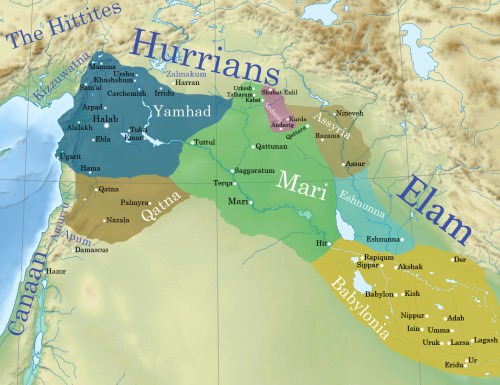
Ancient Syro-Mesopotamia ca. 1764 BCE
In 1761 BCE, Hammurabi - once an ally of Zimri-Lim - captured Mari. It is not known what became of Zimri-Lim, whether he had been betrayed by Hammurabi or died on a military campaign. It is also unknown whether Mari was taken by threat of force - there is no evidence of this or that Mari was preparing to defend itself - or, finding itself leaderless, the city simply gave itself over to Hammurabi who then sent emissaries to seize the riches of the Great Royal Palace over a period of two years.Regardless, sometime between 1759 and 1757 BCE, Hammurabi razed Mari to the ground.
When Hammurabi burned the palace, he unintentionally baked the tablets inside - an event that has occurred in several ancient cities, such as Ebla and Ugarit, where the palace becomes an unintended pottery kiln - thus preserving the tablets for future excavators of the site. Mari never recovered from this destruction, and the city fell into obscurity. The site saw only occasional habitation until the time of Alexander the Great 's successors when it was finally abandoned for good.
MAP
Enki › Who Was
Definition and Origins
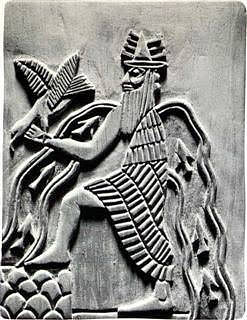
Enki (also known as Ea, Enkig, Nudimmud, Ninsiku) was the Sumerian god of wisdom, fresh water, intelligence, trickery and mischief, crafts, magic, exorcism, healing, creation, virility, fertility, and art. Iconography depicts him as a bearded man wearing a horned cap and long robes as he ascends the Mountain of the Sunrise; flowing streams of water run from his shoulders, emphasizing his association with life-giving water, while trees representing the male and female principle stand in the background. The streams are interpreted as the Tigris and Euphrates Rivers which, according to one myth, were formed from Enki's semen. His name means "Lord of the Earth" and his symbols are the fish and the goat, both representations of fertility.
Originally, Enki (then known as Enkig) was a Sumerian deity of fresh water and patron of the city of Eridu, considered by the Mesopotamians the first city established at the beginning of the world. The god first appears in the Early Dynastic Period IIIa (c. 2600-2350 BCE) and was established as an important god of the Akkadians by c. 2400 BCE who knew him as Ea.Excavations at Eridu, however, have uncovered evidence of a tradition of shrines to Enki dating back to the founding of the city c. 5400 BCE. At Eridu he was known as Enki and later, at Akkad, as Ea; the two names are used interchangably for the same deity as is the Babylonian name Nudimmud. Enki was known as Ninsiku only in his aspect as patron of crafts and art, especially objects devoted to divine subjects.
GENEALOGY & OFFSPRING
Enki was the son of Anu, the sky god, in Sumerian and Akkadian mythology and the son of Apsu, the primordial father, in Babylonian texts. He is also referred to as the son of the goddess Nammu, a primordial mother goddess who gave birth to the earth and heavens. Enki's wife was Ninhursag (also known, among many other names as Ninmah and, originally, as Damgalnuna, the Assyrian Damkina) and their sons were Asarluhi (god of magical knowledge), Enbilulu (god of canals and dikes), the human sage Adapa, and the king of the gods, Marduk (who would later absorb the qualities of Asarluhi). They also had eight children born of Ninhursag's efforts to heal Enki in the myth Enki and Ninhursag : Abu (god of plants and growth);Nintulla (Lord of Dilmun and precious metal); Ninsitu (goddess of healing, wife of healing-god Ninazu); Ninkasi (goddess of beer ); Nanshe (also Nanse, social justice, fertility, divination, and the interpretation of dreams); Azimua (goddess of healing, wife of underworld deity Ningishida); Emshag (Lord of Dilmun, god of fertility) and Ninti (goddess of the rib, giver of life). Enki is also often depicted as the father of one of the most popular and enduring deities, Inanna, goddess of war, sexuality, passion, fertility, love, and prostitutes. He had a twin brother, Adad (also known as Ishkur), god of weather and storms.
ALONG WITH ANU & ENLIL, ENKI MADE UP AN EARLY MESOPOTAMIAN TRIAD WHICH GOVERNED THE HIGH HEAVENS, ATMOSPHERE, & EARTH.
APPEARANCE IN LITERATURE
There are a number of Mesopotamian stories, legends, prayers and royal inscriptions in which Enki plays a major role. He is famously depicted in the works concerning Ninhursag (Ninmah) such as Enki and Ninhursag and Enki and Ninmah both of which concern the creation of the world and humanity. In the Enuma Elish, the Babylonian epic of creation, Enki is the father of the champion Marduk, who defeats the forces of chaos, and is co-creator of the world with his son. Enki also appears in the works The Atrahasis, The Marriage of Ereshkigal and Nergal, Inanna and The God of Wisdom, The Descent of Inanna, Enki and the World Order, Enmerkar and the Lord of Aratta, The Epic of Gilgamesh, and others. He was one of the most important deities in the Mesopotamian Pantheon along with Anu (Lord of Heaven), Enlil (Supreme Lord of Air), and Inanna.Along with Anu and Enlil, Enki made up an early Mesopotamian triad governing the high heavens, atmosphere, and earth. He is also listed among the earliest seven Sumerian deities in the god's list which also includes Anu, Enlil, Ninhursag, Utu, Nanna, and Inanna.
MYTHOLOGICAL ORIGIN FROM ENUMA ELISH
According to the Babylonian Enuma Elish (c. 1100 BCE), Enki was the oldest son of the first gods, Apsu and Tiamat. In the beginning of time, the world was undifferentiated swirling chaos from which separated Apsu, the male principle personified by fresh water and Tiamat, the female principle defined by salt water. Apsu and Tiamat gave birth to the younger gods but these deities had nothing to do and so amused themselves as best as they could. Their constant noise distracted Apsu and interrupted his sleep and so, after consulting with his vizier, he decided to kill them.
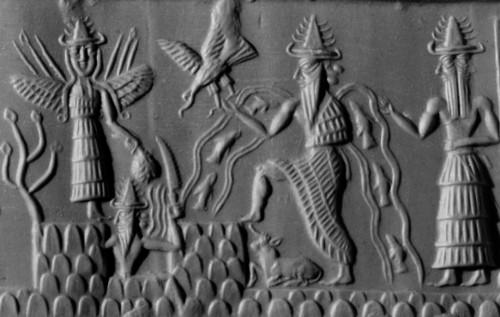
Enki on the Adda Seal
Tiamat overheard their discussion and was horrified by the plan and so whispered it to her son. Enki considered various plans and their consequences and then proceeded with the one he thought best: he put his father into a deep sleep and then killed him. Tiamat never considered such a possibility and disowned her children. She then raised an army of demons and monsters, led by her consort and champion Quingu (sometimes Kingu). This army of the older gods defeated Enki and the younger gods in battle each time they met until the younger group was driven back and began to lose hope.
At this point Enki's son Marduk stepped forth with an offer: if the gods would make him their king, he would lead them to victory. Prior to this, there had been no general overseeing the operations but each god took a turn at command. Once Marduk was elected king, he met Quingu in single combat and defeated him and then shot Tiamat with an arrow so great it split her in two. From her eyes ran the tears which would become the Tigris and Euphrates rivers and her body was used by Marduk to fashion the earth. Quingu, and other gods who had encouraged Tiamat's war, were executed and Quingu's body used to create human beings. Marduk consulted with Enki on all these choices and so Enki is often credited as co-creator of the world and life.
ENKI IN THE ATRAHASIS
The Akkadian/Babylonian story of The Atrahasis (c. 17th century BCE) gives another version of the creation but, still, Enki plays a pivotal role. In this story, the elder gods live a life of leisure and pleasure while making the younger gods do all the work in maintaining creation. The younger gods have no time to rest because there is always so much to do and so Enki proposes that they create lesser beings who will be co-workers with them. They have no idea what to make these new creatures out of until one of the gods, We-llu (also llawela), volunteers himself as a sacrifice and is killed. His flesh, blood, and intelligence are kneaded into clay by the mother goddess Ninhursag from which she creates seven male and seven female human beings. These fourteen new creatures are exceptionally fertile and soon there are hundreds, and then thousands, of people on the earth all doing the work which once occupied the younger gods.
At first, these people are exactly what the gods had hoped for but, as they grow in number, they become louder and more and more of a problem. Their constant noise and difficulties disturb the sleep of Enlil, king of the gods, and distract him from both his daily tasks and his leisure so he decides to cut down the population through a series of plagues. He sends a drought, then pestilence, then famine and, each time, the people appeal to their father-god Enki, the one who first conceived of them, and he helps them by telling them what they should do to return the earth to balance and productivity and their communities to full health.

Map of Sumer
Enlil is frustrated as now there seem to be even more people than when he first tried to get rid of them. He convinces the other gods to allow him to unleash a great flood which will destroy humanity and he is powerful enough to get them all to agree. Enki recognizes the cruelty and injustice of this plan but cannot deter Enlil so he goes to earth and finds an honest man, Atrahasis, one who has always been both wise and kind and has devoted himself to Enki piously. Enki whispers to him to build an ark and enter it with two of every kind of animal.
Atrahasis completes his mission just as the flood begins. The people cry out for help from the gods but no help is offered.Ninhursag weeps for the people and is inconsolable and the other gods also mourn but no one can stop the flood. Enlil recognizes that this flood may not have been the best idea but it is too late now; everyone on earth is dead. The flood waters subside, the ark comes to rest, and Enki whispers to Atrahasis that the time has come for him to open the ship and make sacrifices to the gods. Atrahasis does so and the sweet smell of his sacrifice floats up to heaven from which Enlil looks down to see someone has survived. He instantly knows Enki is behind this and, even though he was only just regretting what he had done, he focuses all his fury on him.
WHEN GIVEN A CHOICE BETWEEN SERVING THE WILL OF THE GODS OR THE NEEDS OF THE PEOPLE, ENKI ALWAYS CHOSE HUMAN INTERESTS & ALWAYS THE PATH OF COMPASSION, FORGIVENESS, & WISDOM.
Enki explains himself, however, and shows how good and kind a man Atrahasis is and directs them all to the sweet sacrifice.The gods are pleased and descend to earth to eat the sacrifice and then Enki proposes a new plan: the gods will create beings who are less fertile: infants will be carried away by demons, women will suffer miscarriages or be infertile, other women will be consecrated to the gods and remain perpetual virgins. Further, humans will not be given very long life spans and, in the time they do live, there will be opportunities daily for their death from many different causes. The gods agree to this proposal;Atrahasis, the last of his kind, is spirited away to the lands of the blessed and Ninhursag creates the new creatures.
ENKI AS TRICKSTER GOD
In both of these stories, Enki acts in the best interest of the community even if that community cannot appreciate it. In the Enuma Elish he defies his mother's hopes in killing Apsu but must do so for the greater good and, in The Atrahasis, he saves one good man to inspire Enlil to give humanity a second chance to live. In most of the other stories he is shown in this same way. In The Marriage of Ereshkigal and Nergal, for example, he arranges events so that Nergal, god of war, will be held in the underworld for six months out of the year, thus preventing warfare and strife during that time.
In The Descent of Inanna he contrives for his daughter's rescue from the underworld after she is killed by her sister Ereshkigal by sending two clever demons to trick the Queen of the Dead into giving them Inanna's corpse. He is shown in the story Inanna and the God of Wisdom as possessor of the meh, the laws and powers concerned with all of life and the gifts of civilization - the possessions of the gods alone - which he allows Inanna to take from him during a drunken party. Although he sends various forces after her to re-capture the meh and return them to him, it seems Inanna gets away with her stolen treasures fairly easily. In this, Enki is seen as he is in other works concerning Inanna: as the father of a daughter who would do anything for her, even if it may not seem the wisest or even the fairest choice under the circumstances. In The Descent of Inanna, after all, Inanna causes her own problems and it is actually Ereshkigal who is wronged and should be aided. In helping Inanna, however, Enki restores balance to the world and, again, makes his choice based on the good of the many.When he allows Inanna to take the meh, he knows she will give the gifts of civilization to humanity just as he knows that the other gods expect him to keep them out of human hands.
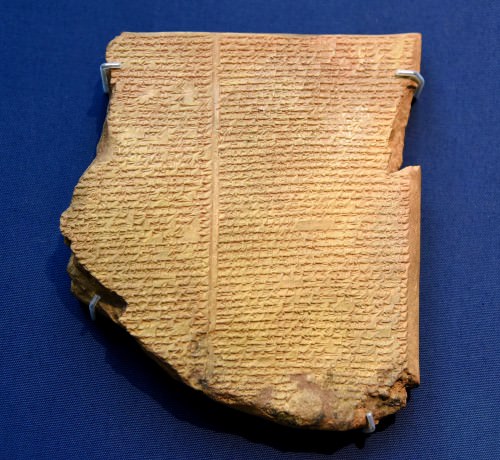
Flood Tablet of the Epic of Gilgamesh
As a trickster god, Enki reveals his wisdom - and so enlightens others - through actions which may not make sense on the surface. This is the case when he allows himself to get drunk and lets Inanna have the meh but also in The Epic of Gilgameshwhen he consents to the death of Enkidu, best friend of the hero Gilgamesh. Enkidu and Gilgamesh have just returned from another triumph when Inanna (known as Ishtar in the story) tries to seduce the hero and Gilgamesh, listing the many other lovers she has had who met with bad ends, refuses her. Inanna sends her sister Ereshkigal's husband, Gugulana (the bull of heaven) to destroy Gilgamesh's realm and Enkidu kills him. For raising his hand against a god, Enkidu must die. Enki consents to this - even though he recognizes Inanna caused the problem - because human beings must not think so highly of themselves that they will challenge the gods. More importantly, however, Enki realizes that Enkidu's death will introduce Gilgamesh to loss and this will lead him to an exploration of the meaning of life which will make him a deeper and more complete individual.
Even in Enki and Ninhursag, where he seduces his grown daughters because they remind him of his wife, Enki is portrayed sympathetically. He is punished for his transgressions which, it is made clear, he was guilty of only out of his great love for Ninhursag and a kind of enchantment he fell under because of missing her. His role as Trickster God is evident in this as his various mis-steps and sins result in the birth of deities favorable to humanity. This same is true in Enki and Ninmah in which Ninmah challenges him to a game while they are drinking beer and Enki manages to best her by creating a being she can do nothing to improve upon. His mischief in all these tales is evidence of his wisdom and his desire to do his best for humanity.
PATRON OF ERIDU & WORSHIP
Enki as patron of the city or Eridu is significant to his role as god of wisdom. Eridu was thought to be the first city created by the gods upon which order and law was conferred at the beginning of time and was later known as the "city of the first kings".Founded c. 5400 BCE, Eridu would remain an important religious center for thousands of years and serve in stories and legends about a "golden age" in the same way that later Hebrew writers would use a Garden of Eden.
Excavations at the city have uncovered shrines to Enki built and re-built at the same location over thousands of years. Even after the god was widely worshipped elsewhere, he continued to be associated with Eridu and the abzu (also absu ), the subterranean waters there. Enki was worshipped primarily at his temple known as E-abzu (House of the Abzu) and E-engur-ra (House of the Subterranean Waters). As with all other important Mesopotamian gods and goddesses, priests tended to the god's statue, temple, and temple complex which served the people in many different ways. The gods' temples were houses of healing, counseling centers, distribution centers, and holy sites. There were no temple services as one would recognize them in the present day and people mainly interacted with the gods during festivals, through communion with the lesser priests, or at home through private rituals.
At Eridu, Enki presided over the abzu but also over the mystical aspects of this primordial marsh from which the city - and life - was thought to have risen. Attended by his minister Isimud, Enki also had assorted creatures at his service such as giants, demons (both protective and destructive), and other mystical beings. Mermen and mermaids were thought to inhabit the watery depths of the abzu beneath the city while the Seven Sages (the abgal) lived with Enki in his palace. In every story or legend, Enki is associated with the heights and depths of universal understanding and is always seen as a friend of humanity.When given a choice between serving the will of the gods or the needs of the people, Enki always chose human interests and always the path of compassion, forgiveness, and wisdom.
LICENSE:
Article based on information obtained from these sources:with permission from the Website Ancient History Encyclopedia
Content is available under License Creative Commons: Attribution-NonCommercial-ShareAlike 3.0 Unported. CC-BY-NC-SA License